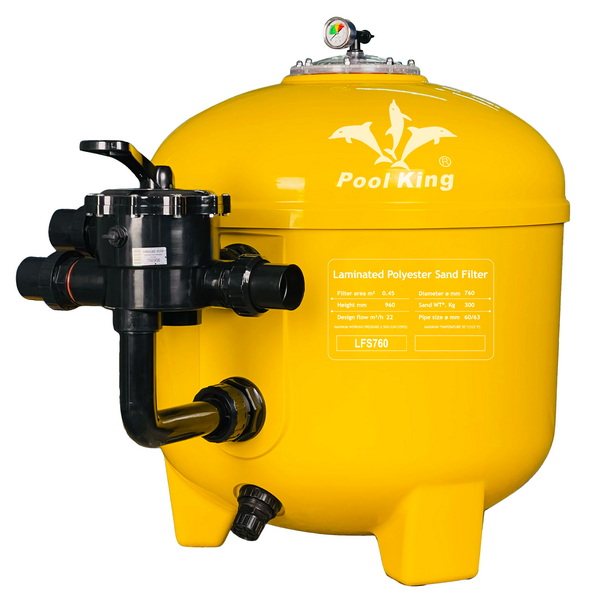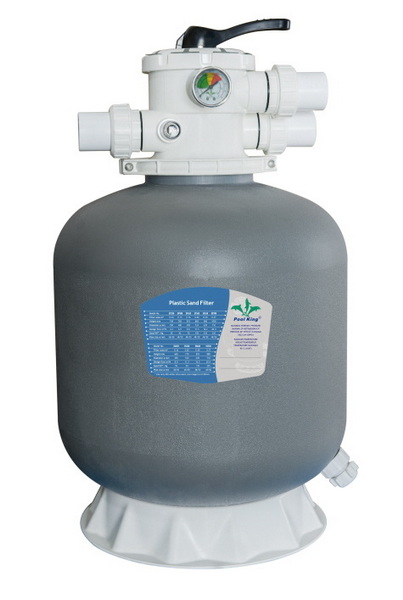Views: 222 Author: Tina Publish Time: 2025-11-02 Origin: Site








Content Menu
● The Role of Sand in Pool Filtration
● Recommended Replacement Intervals
● Signs Your Pool Filter Sand Needs Changing
● Step-by-Step Guide: Replacing Pool Filter Sand
>> Step 1: Drain and Access the Filter
>> Step 2: Remove the Multiport Valve or Dome
>> Step 6: Reassemble and Start the System
● Troubleshooting & Proactive Maintenance
>> Common Issues Post Replacement
● Choosing the Right Filter Sand
>> Benefits of OEM Sand Filter Products
● Maximizing Filter Sand Lifespan
● Advanced Filtration Solutions
● Caring for Pool Filters: Pro Tips
● Frequently Asked Questions (FAQ)
>> 1. How do I know when to change my pool filter sand?
>> 2. Can I use regular sand instead of filter sand?
>> 3. What are the risks of not changing pool filter sand?
>> 4. Is it safe to change pool filter sand myself?
>> 5. Are there alternatives to traditional sand?
A crystal-clear pool is the ultimate goal for any pool owner or facility manager. At the heart of every sparkling swimming pool is an efficient filtration system, and for many, this means relying on the tried-and-true sand filter. Pool filter sand acts as a reliable medium to trap contaminants, particles, and debris, ensuring water clarity and safety. But like every component in your pool system, filter sand has a lifespan—and understanding when and how to change it is critical to maintaining your pool at its best.[1][2]

Sand filters work by pushing pool water through a bed of special grade sand—usually #20 silica sand—where debris is trapped. The clean water is then returned to the pool, free of visible particles and many bacteria. Over time, the sand grains erode and become “rounded” rather than jagged, reducing their filtration capability. Oils, lotions, and tiny organic matter coat the sand, making it less effective. Regular replacement keeps filtration efficiency high and reduces strain on your pump and other components.[2][7]
For most residential pools, pool filter sand should be changed every 3-5 years. How frequently you change it depends on several factors:
- Pool usage: Pools used heavily may require more frequent changes.
- Type of debris: Pools exposed to lots of fine particles, oily substances, or algae should be monitored more closely.
- Maintenance routine: Regular backwashing and chemical balance extend sand life.
Commercial pools with high bather loads typically need sand replaced every 1-2 years. Public pools, resorts, and hotels often have strict water quality standards and safety regulations, making scheduled sand changes a routine part of facility management.[1][2]
Saltwater systems should also follow a 3-5 year replacement cycle, but it's vital to watch for scaling or mineral deposits, which can impact sand effectiveness.
| Pool Type | Sand Replacement Interval | Notes |
|---|---|---|
| Home/Residential | 3–5 years flipr+1 | Heavier use reduces interval |
| Commercial/Public | 1–2 years boutique.piscinehippocampe+1 | High bather load |
| Saltwater | 3–5 years boutique.piscinehippocampe+1 | Watch for scaling effects |
Routine replacement keeps your pool clean, but these signs indicate the sand needs immediate attention:
- Cloudy or murky water that doesn't improve despite normal chemical adjustments.
- High pressure gauge readings (above 15–20 psi) that persist after backwashing.[2]
- Frequent backwashing needed and little or no improvement in water quality.
- Visible sand in the pool, a sign of failed filter laterals or severely damaged sand.
- Channeling inside the filter—water forming paths through clumped sand, reducing filtration efficiency.
- Persistent algae blooms, even with proper chlorination.
- Increased need for chemicals, like chlorine or clarifiers.
- Sand that's more than 3–5 years old, regardless of symptoms; preventative replacement is recommended.[1][2]

Replacing pool filter sand is a task most pool owners can handle with some care and the right tools. Below is a detailed step-by-step guide to ensure the process goes smoothly.
Gather all necessary items:
- Proper pool filter sand (#20 silica is standard)
- A bucket or vacuum cleaner for sand removal
- Hoses for rinsing
- Screwdriver, wrench, or other required tools
- Gloves, mask, and safety glasses
Always ensure the pool pump is turned off and disconnected from power. Lock out the circuit breaker for maximum safety before starting any filter work.[5][6]
- Turn off the pool pump.
- Remove the drain plug at the bottom of the filter to release water.
- Disconnect pipes and hoses attached to the multiport valve. Install unions for easier future maintenance if your system uses solid plumbing.
- Take off the valve carefully. Cover the standpipe with duct tape or cloth to protect it from stray sand entering.
- Scoop out old sand with a cup or use a specialized vacuum. Avoid damaging the fragile filter laterals at the bottom of the tank—these are key to your filter's operation.[4][7]
- Examine the laterals, standpipe, and filter tank for cracks or wear. Replace damaged parts.
- Clean the tank thoroughly using a hose and brush. Ensure no sand or debris remain.
- Add water to the tank first to cushion the laterals for the new sand pour.
- Slowly pour approved sand into the tank, keeping the sand level consistent and not exceeding manufacturer recommendations.
- Reinstall the valve/dome and reconnect all hoses and fittings. Test all seals to prevent leaks.
- Backwash the filter for several minutes, flushing out dust and fine particles.
- Switch to “filter” mode and check the system for leaks or abnormal pressure readings.[7][4][5]
- Monitor water clarity and filter pressure for a few days.
- Adjust chemicals as needed to maintain correct pH and sanitation.
- Sand in pool: Indicates damaged laterals or faulty standpipe—disassemble and replace affected parts.
- Leaking filter tank: Check the O-ring, seals, and connection points.
- High pressure or cloudy water: Ensure the sand is spread evenly and the correct type is used; repeat backwashing.
Replacing sand is manageable for most handy pool owners. For large commercial filters exceeding several hundred kilograms of sand, or if complex plumbing is present, consult a professional. Expert technicians can identify hidden issues and guarantee compliant installation, especially if warranties or health codes are involved.[4][7][2]
Not all sand is created equal. Only use sand specifically labeled for pool filtration. Alternatives include:
- Silica sand (grade #20): Most common and affordable.
- Zeolite sand: Offers finer filtration and better ammonia removal, but is more costly.
- Glass filter media: Highly efficient, recyclable, and long-lasting, but requires a higher upfront investment.
Premium OEM pool filtration products, such as those made in advanced Chinese factories, often feature:
- Automated, precision-made tanks and components;
- Enhanced design for easy sand replacement;
- Compatibility with international pool standards;
- Optional advanced media alternatives for state-of-the-art water clarity.
OEM products typically offer customization, branding opportunities, and technical support for distributors, wholesalers, and overseas manufacturers.
1. Backwash at proper intervals: Typically when pressure rises 8–10 psi above baseline, but avoid excessive backwashing.
2. Maintain pH and chemical balance: Prevents scaling, algae, and sand clumping.
3. Conduct annual deep cleaning: Use enzyme or sand cleaner products to break down organic contaminants.
4. Check internal filter components: During sand change or at least annually—replace worn parts swiftly.
5. Monitor water parameters: Regularly test pH, alkalinity, sanitizer, and calcium hardness.
6. Use only approved sand/media: Never substitute playground or construction sand for filtration.
7. Upgrade to newer media when possible: Glass or zeolite may provide longer service and higher efficiency in demanding settings.[8][10]
Increasingly, pool professionals are investing in filter media upgrades or hybrid systems:
- Glass media: Last 8-10 years, require less frequent cleaning, and can reduce environmental impact due to longer lifespan.
- Zeolite: Known for exceptional clarity, fewer backwashes, and improved chemical reduction.
Modern sand filter systems may include smart sensors, automated backwashing, and integrated cloud management—ideal for resorts and commercial applications.
- Always maintain manufacturer-specified sand height in the tank.
- Replace worn multiport valve gaskets and O-rings to prevent leaks.
- Schedule preventative inspections for public and commercial pools.
- Document all maintenance actions for warranty and regulatory compliance.
- Educate staff or users on basic filter troubleshooting for prompt, effective responses.
Timely pool filter sand replacement is crucial for clear, healthy water, efficient equipment operation, and extended system life. Whether servicing a backyard oasis or a large public pool, following the recommended interval and procedures for sand replacement ensures guest safety and satisfaction. Advanced media, proactive maintenance, and expert OEM filtration solutions can further lift your pool's performance, while regular troubleshooting guards against downtime and costly repairs. If you require premium sand filter systems, OEM supply, or technical consulting, reach out to our team for reliable support and streamlined solutions.

Watch for cloudy water, persistent high pressure readings, frequent backwashing, increased need for chemicals, and visible sand in the pool. Proactive replacement every 3–5 years helps avoid issues.[2][1]
No. Only approved pool filter sand or advanced media (zeolite, glass) should be used. Other sands may damage the filter or fail to clean your water effectively.[7][2]
Skipping sand replacement can result in poor water quality, unhealthy swimming conditions, algae blooms, equipment strain, and increased costs due to excessive chemical use or repairs.[1][2]
Most residential systems can be serviced by handy pool owners following detailed guides. For large or complex systems, professional help may be necessary for safety and compliance.[5][4]
Yes. Many owners upgrade to glass or zeolite media for superior filtration, longer service life, and environmental benefits, but these come at a higher initial cost.[10]
[1](https://boutique.piscinehippocampe.ca/en/blogs/guide-piscine/changer-sable-filtreur-piscine-guide)
[2](https://aisands.com/how-to-replace-sand-in-a-pool-filter/)
[3](https://www.aquaneo.com.au/blog/complete-guide-to-changing-pool-filter-sand/)
[4](https://www.pool.shop/blog/how-do-i-replace-the-filter-sand-for-my-pool/)
[5](https://mrpoolman.com.au/blogs/news/how-to-change-pool-filter-sand)
[6](https://romanellipools.com/blogs/how-to-change-the-sand-in-your-pool-filter-step-by-step-guide/)
[7](https://flipr.shop/blogs/flipr-blog-pools/step-by-step-guide-to-changing-sand-in-a-pool-filter)
[8](https://www.streampumps.com/pump-introductions/how-does-a-sand-filter-pump-work.html)
[9](https://www.youtube.com/watch?v=VxIsKhGyZXQ)
[10](https://www.factorypoolsperth.com.au/a-complete-guide-to-sand-filters/)
[11](https://www.youtube.com/playlist?list=PL4u1wlA7y4EOqmSVeRKbsWU09V6QDpvZg)
[12](https://www.youtube.com/playlist?list=PLD13B4EF8AB358B02)
[13](https://www.youtube.com/watch?v=L0WNAscMYJc)
